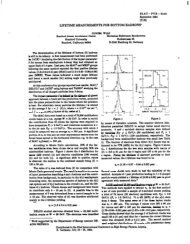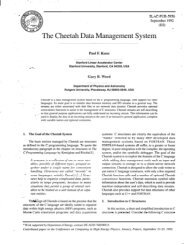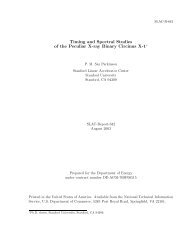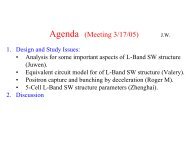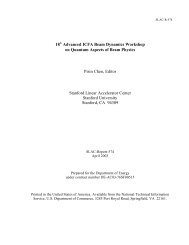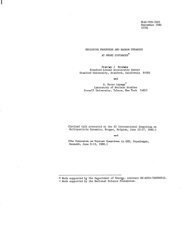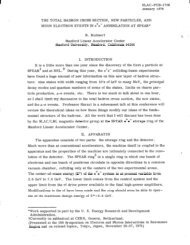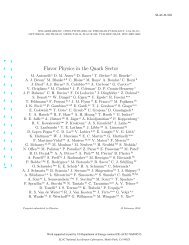The Use and Calibration of the Kern ME5000 Mekometer - SLAC ...
The Use and Calibration of the Kern ME5000 Mekometer - SLAC ...
The Use and Calibration of the Kern ME5000 Mekometer - SLAC ...
You also want an ePaper? Increase the reach of your titles
YUMPU automatically turns print PDFs into web optimized ePapers that Google loves.
<strong>ME5000</strong> Data Reductions<br />
a) Major-Axis: a, <strong>the</strong> semimajor axis <strong>of</strong> <strong>the</strong> reference ellipsoid, in meters. <strong>The</strong> reference figure<br />
used at <strong>SLAC</strong> is Clarke’s ellipsoid <strong>of</strong> 1866, defined by its semimajor a <strong>and</strong> semiminor b axes,*<br />
Fig. 4.<br />
FIGURE 4. Ellipsoid<br />
semimajor axis: a = 6378206.4 m<br />
semiminor axis: b = 6356583.8 m<br />
b) Eccentricity: e*, <strong>the</strong> square <strong>of</strong> <strong>the</strong> first eccentricity,<br />
a* - P<br />
first eccentricity: e* = 7 (26)<br />
c) Latitude: $, <strong>the</strong> latitude <strong>of</strong> <strong>the</strong> site, in degrees.<br />
<strong>The</strong>se first three parameters are used to calculate <strong>the</strong> earth’s radius <strong>of</strong> curvature at <strong>the</strong> site. Since<br />
<strong>the</strong> reference surface is a spheroid not a sphere, <strong>the</strong> radius <strong>of</strong> curvature varies with both latitude<br />
<strong>and</strong> azimuth. At a given latitude <strong>the</strong> curvature is usually expressed in <strong>the</strong> form <strong>of</strong> <strong>the</strong> two<br />
. principal radii <strong>of</strong> curvature, p (referred to as M in some <strong>of</strong> <strong>the</strong> literature) <strong>the</strong> radius <strong>of</strong> curvature<br />
in <strong>the</strong> meridian, <strong>and</strong> v (or N in some <strong>of</strong> <strong>the</strong> literature) <strong>the</strong> radius <strong>of</strong> curvature in <strong>the</strong> prime<br />
vertical, perpendicular to <strong>the</strong> meridian (27-28). <strong>SLAC</strong> is a sufftciently small site that it is<br />
adequate to ignore <strong>the</strong> azimuth <strong>of</strong> <strong>the</strong> line, taking instead <strong>the</strong> mean radius R, which is <strong>the</strong><br />
geometric mean <strong>of</strong> <strong>the</strong> two principal radii, (29).<br />
P<br />
V<br />
a (l-e*)<br />
= (l-e* sin* $)“I<br />
a<br />
= (l-e* sin&$)”<br />
R, = pv<br />
d-<br />
<strong>The</strong> latitude given in <strong>the</strong> example file above is for <strong>the</strong> origin <strong>of</strong> <strong>the</strong> <strong>SLAC</strong> coordinate system,<br />
station 100 at <strong>the</strong> east end <strong>of</strong> <strong>the</strong> linac.<br />
latitude: $ = 37.4168’<br />
mean radius: R, = 6372508.16 m<br />
d) Refheight: <strong>the</strong> reference height to which reduced ellipsoidal distances are projected. This is <strong>the</strong><br />
normal height, in metres, above <strong>the</strong> ellipsoid.<br />
* Ch. 8 SLC Alignment H<strong>and</strong>book, in SLC Design H<strong>and</strong>book, 1984, p. 8-31.<br />
34<br />
(27)<br />
(28)<br />
(2%



